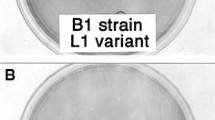Summary
A persistent infection with the Edmonston strain of measles virus was established in HeLa cells in the absence of measles virus antibody (HeLaPI cells). By hemadsorption or immunofluorescence virtually 100 per cent of the cells possessed measles virus components. HeLaPI cells produced no interferon and were not resistant to superinfection with Newcastle disease virus. HeLaPI cells contained both smooth (15–18 nm) and rough (20–35 nm) nucleocapsids as detected by electron microscopy. The virus produced from the HeLaPI cells (MVPI) varied in titer between 1.5 × 102 and 5.5 × 104 PFU/ml, had a smaller plaque size and was more heat resistant than wild-type measles virus. MVPI was also found to be temperature-sensitive. The temperature-sensitivity of MVPI was determined by the efficiency of plaquing at 33° and 39° C in Vero cell monolayers. When HeLaPI cells were incubated at 33° C, there was a 50-fold increase in virus production as well as a slight increase in the percentage of cells forming infectious centers compared to HeLaPI cells grown at 37° C. MVPI readily established a persistent infection in HeLa cells which also released temperature-sensitive virus.
Similar content being viewed by others
References
Armen, R. C.: Studies on a persistent infection of HeLa cells by measles virus. Ph. D. Thesis. The University of Oregon Health Sciences Center, Portland, Oregon (1976).
Bergholz, C. M., Kiley, M. P., Payne, F. E.: Isolation and characterization of temperature sensitive mutants of measles virus. J. Virol.16, 192–202 (1975).
Cummiskey, J. F., Hallum, J. V., Skinner, M. S., Leslie, G. A.: Persistent Newcastle disease virus infection in embryonic chicken tracheal organ cultures. Infect. Immun.8, 657–664 (1973).
Drake, J. W., Lay, P. A.: Host controlled variation in NDV. Virology17, 54–64 (1962).
Gould, E. A., Linton, P.: The production of a temperature-sensitive persistent measles virus infection. J. gen. Virol.28, 21–28 (1975).
Haspel, M. V., Duff, R., Rapp, F.: The isolation and preliminary characterization of temperature-sensitive mutants of measles virus. J. Virol.16, 1000–1009 (1975).
Haspel, M. V., Knight, P. R., Duff, R. G., Rapp, F.: Activation of a latent measles virus infection in hamster cells. J. Virol.12, 690–695 (1973).
Hayflick, L., Stanbridge, E.: Isolation and identification of mycoplasma from human clinical materials. Annals N.Y. Acad. Sci.143, 608–621 (1967).
Homma, H.: Host-induced modification of Sendai virus. In: Mahy, B. W. J., Barry, R. D. (eds.), Negative Strand Viruses, Vol. 2, 685–698. New York: Academic Press 1975.
Lowry, O. H., Rosebough, N. J., Farr, A. L., Randal, R. J.: Protein measurement with the Folin phenol reagent. J. biol. Chem.193, 205–209 (1951).
Luster, M. I., Armen, R. C., Hallum, J. V., Leslie, G. A.: Measles virus-specific IgD antibodies in patients with subacute sclerosing panencephalitis. Proc. Nat. Acad. Sci. U.S.A.73, 1297–1299 (1976).
Minagawa, T.: Studies on the persistent infection with measles virus in HeLa cells. II. The properties of carried virus. Japan. J. Microbiol.15, 333–340 (1971).
Nakai, M., Imagawa, D. T.: Electron microscopy of measles virus replication. J. Virol.3, 187–197 (1969).
Norrby, E.: A carrier cell line of measles virus in LU 106 cells. Arch. ges. Virusforschung20, 215–224 (1967).
Oyanagi, S., ter Meulen, V., Katz, M., Koprowski, H.: Comparison of subacute sclerosing panencephalitis and measles viruses: An electron microscope study. J. Virol.7, 176–187 (1971).
Preble, O. T., Youngner, J. S.: Temperature-sensitive mutants isolated from L-cells persistently infected with Newcastle disease virus. J. Virol.9, 200–206 (1972).
Preble, O. T., Youngner, J. S.: Temperature-sensitive viruses and the etiology of chronic and inapparent infections. J. inf. Dis.131, 467–473 (1975).
Rustigian, R.: Persistent infection of cells in culture by measles virus. I. Development and characteristics of HeLa sublines persistently infected with complete virus. J. Bact.92, 1792–1804 (1966).
Scheid, A., Choppin, P. W.: Identification of biological activities of paramyxovirus glycoproteins. Activation of cell fusion, hemolysis, and infectivity by protolytic cleavage of an inactive precursor protein of Sendai virus. Virology57, 475–490 (1974).
Shenk, T. E., Koshelmyk, K. A., Stollar, U.: Temperature-sensitive virus fromAedes albopictus cells chronically infected with Sindbis virus. J. Virol.13, 439 to 447 (1974).
Simpson, R. W., Iinuma, M.: Recovery of infectious proviral DNA from mammalian cells infected with respiratory syncytial virus. Proc. Nat. Acad. Sci. U.S.A.72, 3230–3234 (1975).
Stenback, W. A., Durand, D. P.: Host influence on the density of Newcastle disease virus. Virology20, 543–551 (1963).
Thacore, H., Youngner, J. S.: Cells persistently infected with Newcastle disease virus. I. Properties of mutants isolated from persistently infected L cells. J. Virol.4, 244–251 (1969).
U.S. Department of Health, Education and Welfare. A guide to the performance of the standardized diagnostic CF method and adaption to microtest. Public Health Monograph no. 74. Public Health Service July 1969.
Walker, D. L.: Persistent viral infection in cell cultures. In:Sanders, M., Lennette, E. H. (eds.), Medical and Applied Virology, 99–109. St. Louis, Mo.: Warren H. Green 1968.
Youngner, J. S., Dubovi, E. J., Quagliana, D. O., Kelly, M., Preble, O. T.: Role of temperature-sensitive mutants in persistent infections initiated with vesicular stomatitis virus. J. Virol.19, 90–101 (1976).
Youngner, J. S., Quagliana, D. D.: Temperature-sensitive mutants isolated from hamster and canine cell lines persistently infected with Newcastle disease virus. J. Virol.16, 1332–1336 (1975).
Youngner, J. S., Quagliana, D. D.: Temperature-sensitive mutants of vesicular stomatitis virus are conditionally defective particles that interfere with and are rescued by wild-type virus. J. Virol.19, 102–107 (1976).
Author information
Authors and Affiliations
Additional information
With 2 Figures
Rights and permissions
About this article
Cite this article
Armen, R.C., Evermann, J.F., Truant, A.L. et al. Temperature-sensitive mutants of measles virus produced from persistently infected HeLa cells. Archives of Virology 53, 121–132 (1977). https://doi.org/10.1007/BF01314853
Received:
Accepted:
Issue Date:
DOI: https://doi.org/10.1007/BF01314853




